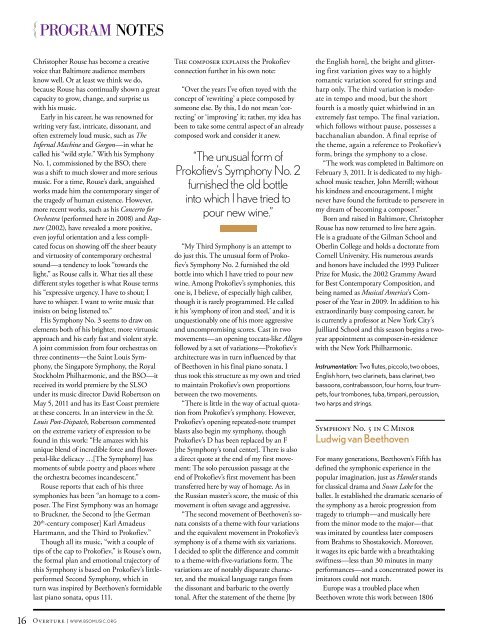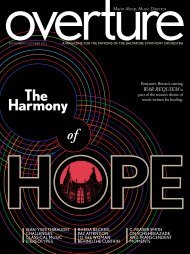November–December 2012 - Baltimore magazine
November–December 2012 - Baltimore magazine
November–December 2012 - Baltimore magazine
You also want an ePaper? Increase the reach of your titles
YUMPU automatically turns print PDFs into web optimized ePapers that Google loves.
{ Program notes<br />
Christopher Rouse has become a creative<br />
voice that <strong>Baltimore</strong> audience members<br />
know well. Or at least we think we do,<br />
because Rouse has continually shown a great<br />
capacity to grow, change, and surprise us<br />
with his music.<br />
Early in his career, he was renowned for<br />
writing very fast, intricate, dissonant, and<br />
often extremely loud music, such as The<br />
Infernal Machine and Gorgon—in what he<br />
called his “wild style.” With his Symphony<br />
No. 1, commissioned by the BSO, there<br />
was a shift to much slower and more serious<br />
music. For a time, Rouse’s dark, anguished<br />
works made him the contemporary singer of<br />
the tragedy of human existence. However,<br />
more recent works, such as his Concerto for<br />
Orchestra (performed here in 2008) and Rapture<br />
(2002), have revealed a more positive,<br />
even joyful orientation and a less complicated<br />
focus on showing off the sheer beauty<br />
and virtuosity of contemporary orchestral<br />
sound—a tendency to look “towards the<br />
light,” as Rouse calls it. What ties all these<br />
different styles together is what Rouse terms<br />
his “expressive urgency. I have to shout; I<br />
have to whisper. I want to write music that<br />
insists on being listened to.”<br />
His Symphony No. 3 seems to draw on<br />
elements both of his brighter, more virtuosic<br />
approach and his early fast and violent style.<br />
A joint commission from four orchestras on<br />
three continents—the Saint Louis Symphony,<br />
the Singapore Symphony, the Royal<br />
Stockholm Philharmonic, and the BSO—it<br />
received its world premiere by the SLSO<br />
under its music director David Robertson on<br />
May 5, 2011 and has its East Coast premiere<br />
at these concerts. In an interview in the St.<br />
Louis Post-Dispatch, Robertson commented<br />
on the extreme variety of expression to be<br />
found in this work: “He amazes with his<br />
unique blend of incredible force and flowerpetal-like<br />
delicacy …[The Symphony] has<br />
moments of subtle poetry and places where<br />
the orchestra becomes incandescent.”<br />
Rouse reports that each of his three<br />
symphonies has been “an homage to a composer.<br />
The First Symphony was an homage<br />
to Bruckner, the Second to [the German<br />
20 th -century composer] Karl Amadeus<br />
Hartmann, and the Third to Prokofiev.”<br />
Though all its music, “with a couple of<br />
tips of the cap to Prokofiev,” is Rouse’s own,<br />
the formal plan and emotional trajectory of<br />
this Symphony is based on Prokofiev’s littleperformed<br />
Second Symphony, which in<br />
turn was inspired by Beethoven’s formidable<br />
last piano sonata, opus 111.<br />
16 Overture | WWW.bSomuSIc.org<br />
The composer explains the Prokofiev<br />
connection further in his own note:<br />
“Over the years I’ve often toyed with the<br />
concept of ‘rewriting’ a piece composed by<br />
someone else. By this, I do not mean ‘correcting’<br />
or ‘improving’ it; rather, my idea has<br />
been to take some central aspect of an already<br />
composed work and consider it anew.<br />
“The unusual form of<br />
Prokofiev’s Symphony no. 2<br />
furnished the old bottle<br />
into which I have tried to<br />
pour new wine.”<br />
“My Third Symphony is an attempt to<br />
do just this. The unusual form of Prokofiev’s<br />
Symphony No. 2 furnished the old<br />
bottle into which I have tried to pour new<br />
wine. Among Prokofiev’s symphonies, this<br />
one is, I believe, of especially high caliber,<br />
though it is rarely programmed. He called<br />
it his ‘symphony of iron and steel,’ and it is<br />
unquestionably one of his more aggressive<br />
and uncompromising scores. Cast in two<br />
movements—an opening toccata-like Allegro<br />
followed by a set of variations—Prokofiev’s<br />
architecture was in turn influenced by that<br />
of Beethoven in his final piano sonata. I<br />
thus took this structure as my own and tried<br />
to maintain Prokofiev’s own proportions<br />
between the two movements.<br />
“There is little in the way of actual quotation<br />
from Prokofiev’s symphony. However,<br />
Prokofiev’s opening repeated-note trumpet<br />
blasts also begin my symphony, though<br />
Prokofiev’s D has been replaced by an F<br />
[the Symphony’s tonal center]. There is also<br />
a direct quote at the end of my first movement:<br />
The solo percussion passage at the<br />
end of Prokofiev’s first movement has been<br />
transferred here by way of homage. As in<br />
the Russian master’s score, the music of this<br />
movement is often savage and aggressive.<br />
“The second movement of Beethoven’s sonata<br />
consists of a theme with four variations<br />
and the equivalent movement in Prokofiev’s<br />
symphony is of a theme with six variations.<br />
I decided to split the difference and commit<br />
to a theme-with-five-variations form. The<br />
variations are of notably disparate character,<br />
and the musical language ranges from<br />
the dissonant and barbaric to the overtly<br />
tonal. After the statement of the theme [by<br />
the English horn], the bright and glittering<br />
first variation gives way to a highly<br />
romantic variation scored for strings and<br />
harp only. The third variation is moderate<br />
in tempo and mood, but the short<br />
fourth is a mostly quiet whirlwind in an<br />
extremely fast tempo. The final variation,<br />
which follows without pause, possesses a<br />
bacchanalian abandon. A final reprise of<br />
the theme, again a reference to Prokofiev’s<br />
form, brings the symphony to a close.<br />
“The work was completed in <strong>Baltimore</strong> on<br />
February 3, 2011. It is dedicated to my highschool<br />
music teacher, John Merrill; without<br />
his kindness and encouragement, I might<br />
never have found the fortitude to persevere in<br />
my dream of becoming a composer.”<br />
Born and raised in <strong>Baltimore</strong>, Christopher<br />
Rouse has now returned to live here again.<br />
He is a graduate of the Gilman School and<br />
Oberlin College and holds a doctorate from<br />
Cornell University. His numerous awards<br />
and honors have included the 1993 Pulitzer<br />
Prize for Music, the 2002 Grammy Award<br />
for Best Contemporary Composition, and<br />
being named as Musical America’s Composer<br />
of the Year in 2009. In addition to his<br />
extraordinarily busy composing career, he<br />
is currently a professor at New York City’s<br />
Juilliard School and this season begins a twoyear<br />
appointment as composer-in-residence<br />
with the New York Philharmonic.<br />
Instrumentation: Two flutes, piccolo, two oboes,<br />
english horn, two clarinets, bass clarinet, two<br />
bassoons, contrabassoon, four horns, four trumpets,<br />
four trombones, tuba, timpani, percussion,<br />
two harps and strings.<br />
Symphony No. 5 in C Minor<br />
ludwig van Beethoven<br />
For many generations, Beethoven’s Fifth has<br />
defined the symphonic experience in the<br />
popular imagination, just as Hamlet stands<br />
for classical drama and Swan Lake for the<br />
ballet. It established the dramatic scenario of<br />
the symphony as a heroic progression from<br />
tragedy to triumph—and musically here<br />
from the minor mode to the major—that<br />
was imitated by countless later composers<br />
from Brahms to Shostakovich. Moreover,<br />
it wages its epic battle with a breathtaking<br />
swiftness—less than 30 minutes in many<br />
performances—and a concentrated power its<br />
imitators could not match.<br />
Europe was a troubled place when<br />
Beethoven wrote this work between 1806



